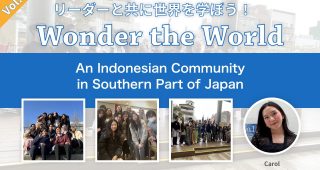レポート
Wonder the World Vol.1: “Discovering the world beneath our feet” (足元の世界を見てみよう!)
マヒ(インド出身)。
環境問題に熱意を持ち、日本で環境サステナビリティの修士号を取得しています。
環境、そしてわたしたちができることの大切さを知ってもらうため、を今回は(身近な)「土」をトピックに投げかけをしてくれています。
KUMONのイマージョン活動に2016年から参加し、子どもたちの成長、そして社会に貢献をしてくれています。
Mahi from India, who got her Master’s degree in environmental sustainability and she is so passionate about the environment, wants to share with us all about the topic of Soil. And she also wants everyone to keep in mind the importance of the environment and what we can do.
She has joined many Kumon English Immersion Activities (KEIA) since 2016 and has been continuing to support children’s growth and contribute to society in her own way through her passion.

Discovering the world beneath our feet!
Namaste everyone. My name is Mahi and I am from India. I came to Japan in 2015 to study at Ritsumeikan Asia Pacific University (APU). At my university, I learned in depth about environmental issues and felt motivated to think of solutions to them. So, I pursued my master’s in Environmental Management at Kyoto University. Now, I work in Tokyo in an environmental consulting company.
It is autumn now, my favorite season! Did you all enjoy the autumn foliage? It is so magical! These amazing trees exist thanks to the help of many magic ingredients. But a very important ingredient is right below our feet: the soil! 5th December is World Soil Day. To commemorate(記念する), let us explore the world beneath our feet together!
The source of soil’s magic
Soil gets its magical powers from all the microorganisms(雑菌たち) that live in it. 1 teaspoon of soil contains more living things than there are people on this planet! There are so many different kinds of organisms in the soil!
Quiz 1. How many of these organisms have we discovered?
- 50%
- 25%
- 10%
- 1%
The answer is 4. We only know 1% of the billions of microorganisms in the soil. These undiscovered organisms help us in important ways.
They have the amazing ability to take back the nutrients(栄養素) from things we call “waste” (like kitchen waste, body waste, leaf litter, animal carcasses, etc). The plants then take up these nutrients and give us delicious and nutritious food. So the next time you eat delicious persimmon, remember that the microorganisms in the soil helped create this!
Let us find out more ways the soil helps us!
Quiz 2. Can you tell the difference between these two pictures?

- A is sand(砂質土) and B is fertile soil(肥沃土)
- Soil in A has less carbon content(炭素含有量) and Soil in B has more carbon content
- Soil in A cannot hold water but soil in B can hold water
- All of the above
The answer is 4) All of the above!
Sand (picture A) is very dry and often found in deserts or beaches. Fertile soil (Picture B) is often found near rivers or on the farm. It is good for growing plants. The soil in A has less carbon content compared to B. Every living being has carbon in its body, including us. So, when animal, plant and human waste goes into the soil, the carbon is also added back. Unlike sand, fertile soil has structure because of its carbon content. This helps absorb and store water. Water is very important to us all. Thus, sandy soil cannot hold water, unlike fertile soil. This is why picture B has more plants growing in it than picture A.
Without carbon content, our soil will turn into sandy deserts!
As you can see, what we consider “waste” is very useful to the soil. This ‘world soil day’, let us remember its importance in our lives. Since soil loves “waste”, we can try to compost our kitchen waste! If you want to try composting, click on this link to create compost in a cardboard box:
- https://www.city.nagoya.jp/kankyo/page/0000060262.html (courtesy of Nagoya City office in allowing to share)
I hope you all enjoyed reading this article. Can’t wait to see you all in another article!
Let us find out more ways the soil helps us!
この記事のまとめ
土の中には、様々な微生物がいます。動物、植物、人間の排泄物が土の中に入ると、炭素が追加され肥沃な土壌となります。土は、私たちが「廃棄物」と呼んでいるもの(台所のゴミ、排せつ物、落ち葉、動物の死体など)から栄養素を取り戻す驚くべき力を持っているのです。
植物はこれらの栄養素を吸収し、おいしくて栄養価の高い食べ物に育ちます。土の中身が大変重要なのです。私たちが「廃棄物」としてすてているものが、土壌にとっては非常に役立ちます。土は「ゴミ」が大好き!生ゴミを堆肥にすることもできます。堆肥作りに興味があれば、段ボール箱で堆肥づくりに挑戦してみてね!
New words List
commemorate:記念する
microorganisms: 雑菌たち
nutrients:栄養素
sand:砂質土
fertile soil:肥沃土
carbon content : 炭素含有量
この記事の感想を、ぜひ教えてね!
この記事が気に入ったら、ハートのボタンを押してね!
バックナンバー

Wonder the World Vol.21: “Capture the moment! Into the world of photos”(その瞬間を捉えよう!写真の世界へ)
アンドリュー(コロンビア出身)みなさん、こんにちは!私はアンドリューです。ここ日本で起業家精神を専攻する大学 2 年生です。私は南米のとてもカラフルな国、コロンビアの出身です。今日は、私の...

Wonder the World Vol.10: “Memories of rich and flavorful foods from Bangladesh”(バングラデシュの豊かな味わい深い食べ物の思い出)
アビッド (バングラデシュ出身)2022 年から公文グローバル ネットワーク チーム主催の英語イマージョン活動でグループ リーダーを務めている。大分県別府市の立命館アジア太平洋大学(APU...

Wonder the World Vol.11: “An Indonesian Community in Southern Part of Japan”(日本の南部(大分県別府市)にあるインドネシア人コミュニティ)
キャロル(インドネシア出身)現在は大分県別府市にある立命館アジア太平洋大学の学生。KUMONイングリッシュイマージョンアワー(EIH)のグループリーダー。 日本の南部(大分県別府市)にある...

















